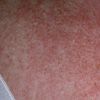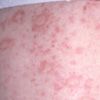Follicular Eczema and Drug Reaction to Dexamethasone
Dermclinic

Case 1:
For several weeks, a 28-year-old woman has had a pruritic eruption on her trunk. She has seasonal allergies that are well controlled with a non-sedating oral antihistamine. Recently, she started a new exercise program.
Which of these questions would be reasonable to ask?
A. What kind of soap do you use?
B. What do you use to cleanse with (eg, washcloth, sponge, poof)?
C. How often do you bathe?
D. What kind of detergent do you use?
E. What kind of fabric softener do you use?
F. Have you worn any new clothing recently?
G. Do you have any pets in the house?
The differential diagnosis includes which of the following?
H. Irritant reaction to soap.
I. Asteatosis from overzealous cleansing.
J. Contact dermatitis from detergent.
K. Contact dermatitis from fabric softener.
L. Contact dermatitis from new clothing.
M. Pet dander allergy.
(Answer on next page.)

Case 1: Follicular eczema
It is reasonable to question this patient with atopy about her bathing habits (A, B, and C). Follicular eczema developed after she increased her frequency of bathing-as a result of the new exercise regimen-and started to use a poof (H and I). Use of a mild cleanser, a reduction in water temperature and duration of bathing, and application of a moisturizer ameliorated her symptoms.
Detergent and fabric softener reactions are most commonly seen where clothing is tightest and where moisture accumulates. New clothing can be a culprit, depending on the distribution and history, if it has not been laundered first. Pet dander is not a likely suspect in older children and adults who do not have a previous history of this allergy.

Case 2:
An inhaled bronchodilator, an antihistamine, and a short tapering course of dexamethasone were prescribed for a 29-year-old woman with asthma. Shortly thereafter, a pruritic rash developed. Her only other medication is an oral contraceptive, which she has been taking for several years.
What is the most likely cause of the rash?
A. Drug reaction to the inhaled bronchodilator.
B. Drug reaction to the antihistamine.
C. Drug reaction to dexamethasone.
D. Drug reaction to the oral contraceptive.
E. Atopic flare.
F. Contact dermatitis.
(Answer on next page.)

Case 2: Drug reaction to dexamethasone
This patient had an allergic reaction to dexamethasone, C, which is fortunately uncommon. She was successfully treated with prednisone; this agent is sufficiently structurally dissimilar to dexamethasone so as to be effective without exacerbating her symptoms. In patients who have a mild reaction, discontinuation of the offending drug may be sufficient treatment.
Inhaled bronchodilators, antihistamines, and oral contraceptives are rarely associated with drug reactions. An atopic flare would occur in the distribution of the flexural folds. Contact dermatitis was ruled out by the absence of a history of contactant exposure.